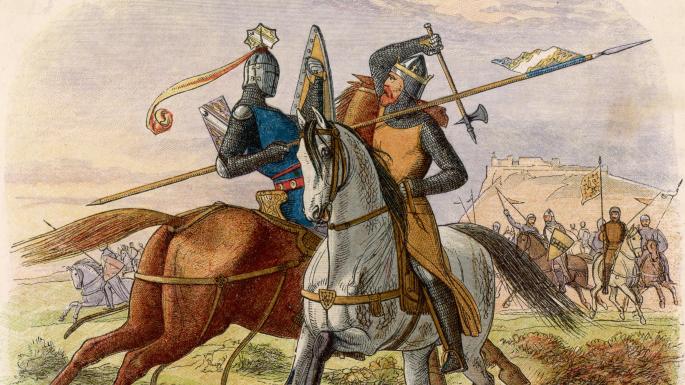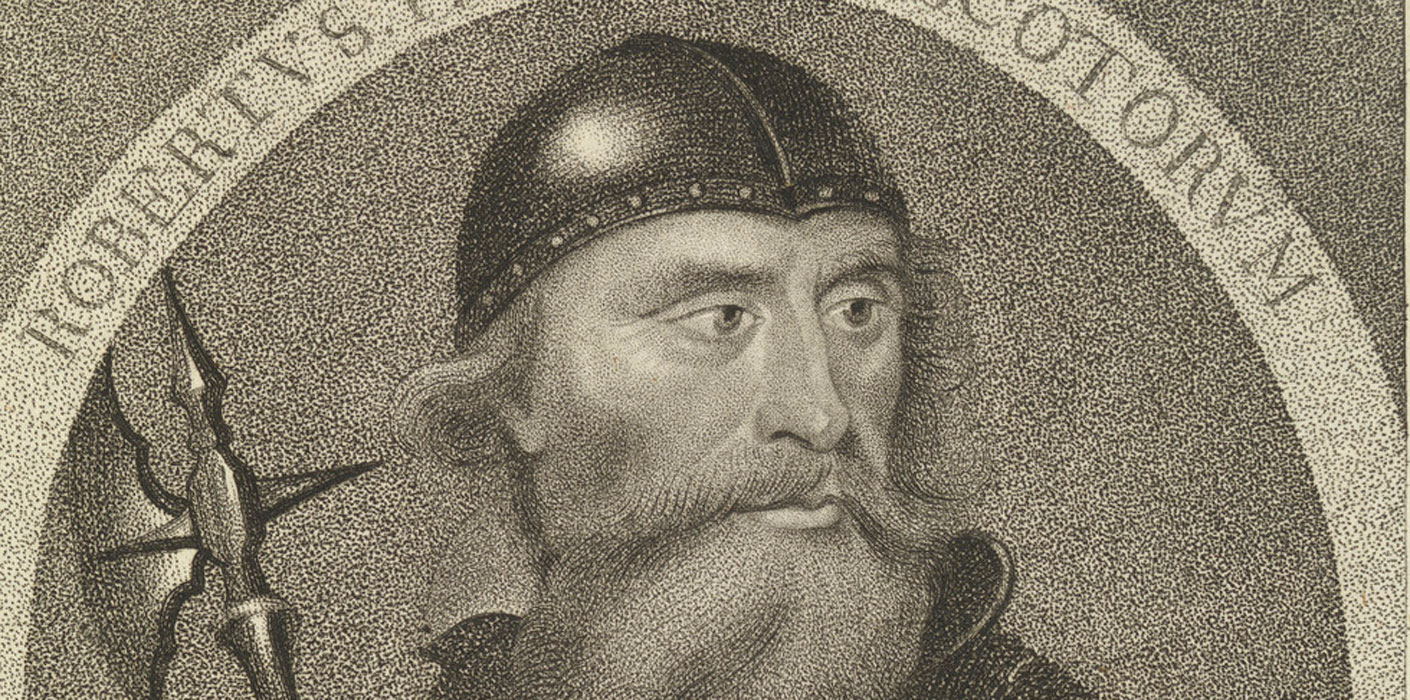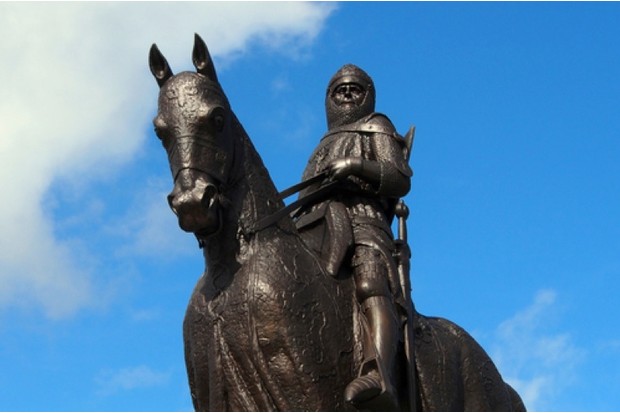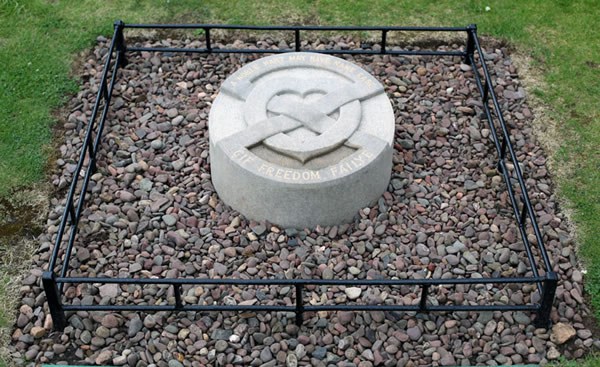Robert the Bruce was born on 11 July 1274 into an aristocratic Scottish family, related to the Scottish royal family. In 1306, Bruce had a bit of a fray with his competitor to the throne, John Comyn, who stabbed him in a church in Dumfries. He was then outlawed by King Edward I and excommunicated by the Pope. Bring on Netflix and the Outlaw King! 27 March 1306, Bruce was crowned king on Moot Hill at Scone Abbey in Scone, just over the River Tay from Perth . The following year his wife and daughters were imprisoned and three of his brothers were executed – meaning the Bruce went into hiding. What do we know (historic facts)? He is descended from Anglo-Norman and Gaelic nobility, his fourth-great grandfather was King David I. Robert’s grandfather, Robert de Brus, 5th Lord of Annandale, was one of the claimants to the Scottish throne during the “Great Cause”. Robert I (11 July 1274 – 7 June 1329), popularly The Bruce (Medieval Gaelic: Roibert a Briuis; modern Scottish Gaelic: Raibeart Bruis; Norman French: Robert de Brus or Robert de Bruys; Early Scots: Robert Brus; Latin: Robertus Brussius), was King of Scots from 1306 until his death in 1329. – in Scotland a national hero. He is buried at Dunfermline in Scotland and famously requested that his heart be taken to the Holy Land, but it only got as far as Spain before an army of Moorish knights attacked the Scottish knights. The Bruce’s heart was saved and along with the knights who attempted to take it to the burial place of Christ in Jerusalem, it was returned to Scotland and buried in Melrose Abbey. Even after Bannockburn, Edward II refused to give up his claim to the over lordship of Scotland and managed a network of spies in Scotland. In 1320 AD leading Scottish earls, barons and the ‘community of the realm’ drafted the ‘Declaration of Arbroath’ reasserting the antiquity of the Scottish people and their monarchy and sent it to Pope John XXII. Having declared Robert the Bruce to be their rightful monarch, four years later, Robert received papal recognition as king of an independent Scotland.
In February 1306, Bruce moved quickly to seize the throne and was crowned King of Scots on 25 March 1306. Edward I’s forces defeated Robert in battle, forcing him to flee into hiding in the Hebrides and Ireland before returning in 1307 to defeat an English army at Loudoun Hill, people seem to forget this battle. In 1309 he held his first parliament. A series of military victories between 1310 and 1314 won him control of much of Scotland, and at the Battle of Bannockburn in 1314, Robert defeated a much larger English army under Edward II of England. The battle marked a significant point, Robert’s armies now free to launch devastating raids throughout northern England, while extending his war against the English to Ireland by sending an army to invade there and by appealing to the Irish to rise against Edward II’s rule. This eventually failed (read; his brother let him down) but that’s another story! In 1324, the Pope recognised Robert I as king of an independent Scotland and in 1326, the Franco-Scottish alliance was renewed in the Treaty of Corbeil. In 1327, the English deposed Edward II in favour of his son, Edward III, and peace was concluded between Scotland and England with the Treaty of Edinburgh-Northampton, by which Edward III renounced all claims to sovereignty over Scotland.
Wee bit more on our hero king … Robert de Brus, 1st Lord of Annandale, the first of the Bruce, arrived in Scotland with David I in 1124 and was given the lands of Annandale in Dumfries and Galloway. Robert was one of ten children, and the eldest son, of Robert de Brus, 6th Lord of Annandale, and Marjorie Countess of Carrick, and claimed the Scottish throne as a fourth great-grandson of David I. From his mum he inherited the Earldom of Carrick, and through his father, a royal lineage. The Bruces also held substantial estates in Aberdeenshire, County Antrim (Ireland), County Durham, Essex, Middlesex and Yorkshire (England). Where he lived as a lad, Annandale was a feudalised society and a form of Middle English would later develop into the Scots language was spoken throughout the region. Carrick was historically an part of Galloway, the society of Carrick in the thirteenth century remained Celtic and Gaelic speaking (Irish or Erse). As heir Robert would have spoken Gaelic, French and Latin. His family would have moved between the castles of Lochmaben, the main castle of the lordship of Annandale, Turnberry and Loch Doon Castle, the castles of the earldom of Carrick. As a part of his childhood Robert, Edward and the other Bruce brothers (Neil, Thomas and Alexander), also lived through the Gaelic tradition of being fostered to allied Gaelic kins and Irish families.
According to historians Barrow and Penman, Robert and Edward Bruce reached the male age of consent of 12, they began training for full knighthood and sent for a period with one or more allied English noble families, such as the de Clares of Gloucester, or even in the English royal household. This raises the possibility that young Robert was in a royal centre which Edward I himself would visit during his reign. Robert’s first appearance in history is on a witness list of a charter issued by Alexander Og MacDonald, Lord of Islay. His name appears in the company of the Bishop of Argyll, the vicar of Arran, a Kintyre clerk, his father, and a host of Gaelic notaries from Carrick. Robert Bruce, the king to be, was sixteen years of age when Margaret, Maid of Norway died in 1290. In 1302, Bruce married his second wife that year, Elizabeth de Burgh, the daughter of Richard de Burgh, 2nd Earl of Ulster (Ireland). By Elizabeth he had four children: David II, John (died in childhood), Matilda (who married Thomas Isaac and died at Aberdeen 20 July 1353), and Margaret (who married William de Moravia, 5th Earl of Sutherland in 1345).
According to Barbour and Fordoun, in the late summer of 1305, a secret agreement sworn, signed, and sealed, John Comyn agreed to forfeit his claim to the Scottish throne in favour of Robert Bruce upon receipt of the Bruce lands in Scotland should an uprising occur led by Bruce. Whether the details of the agreement with Comyn are correct or not, King Edward moved to arrest Bruce while Bruce was still at the English court. Ralph de Monthermer learned of Edward’s intention and warned Bruce by sending him twelve pence and a pair of spurs. Bruce took the hint, and he and a squire their way quickly for Scotland. According to Barbour, Comyn betrayed his agreement with Bruce to King Edward I, and when Bruce arranged a meeting for 10 February 1306 with Comyn in the Chapel of Greyfriars Monastery in Dumfries and accused him of treachery, they came to blows, you know the rest! Bruce asserted his claim to the Scottish crown and began his campaign by force for the independence of Scotland.
English records still in existence today, tell a completely different story, well they would wouldn’t they. They state the Comyn murder was planned. No records have ever been found in England stating that King Edward had any knowledge of treachery by Robert Bruce before his acts against Comyn, here we go again, English saying untruths, it carries on to today by the way when Scotland is mentioned in the same breath. Bruce was crowned King of Scots by Bishop William de Lamberton at Scone, near Perth, on Palm Sunday 25 March 1306. The royal robes and vestments that Robert Wishart had hidden from the English were brought out by the Bishop and set upon King Robert. The bishops of Moray and Glasgow were in attendance as well as the earls of Atholl, Menteith, Lennox, and Mar. The great banner of the kings of Scotland was planted behind his throne. Isabella MacDuff, Countess of Buchan and wife of John Comyn, 3rd Earl of Buchan (a cousin of the murdered John Comyn) arrived the next day, too late for the coronation. She claimed the right of her family, the MacDuff Earl of Fife, to crown the Scottish king for her brother, Donnchadh IV, Earl of Fife, who was not yet of age, and in English hands. So a second coronation was held and once more the crown was placed on the brow of Robert Bruce, Earl of Carrick, Lord of Annandale, King of the Scots. The only king to crowned twice.
It is still uncertain where Bruce spent the winter of 1306–07. Most likely he spent it in the Hebrides, possibly sheltered by Christina of the Isles. The latter was married to a member of the Mar clan, a family to which Bruce was related (not only was his first wife a member of this family, but her brother, Gartnait, was married to a sister of Bruce). Ireland is also a possibility, and Orkney (under Norwegian rule at the time) or Norway are not impossible. In March 1309, Bruce held his first Parliament at St. Andrews, and by August he controlled all of Scotland north of the River Tay. The following year, the clergy of Scotland recognised Bruce as king at a general council.
Battle of Bannockburn in 1314 is a totally separate story, I do not want to delve into this just the now.
Freed from English threats, Scotland’s armies could now invade northern England. Bruce also drove back a subsequent English expedition north of the border and launched raids into Yorkshire and Lancashire. Bruce’s forces also invaded Ireland in 1315, to free the country from English rule (having received a reply to offers of assistance from Donal O’Neil, king of Tyrone), and to open a second front in the continuing wars with England. The Irish even crowned Edward Bruce as High King of Ireland in 1316. Robert later went there with another army to assist his brother. Bruce’s Irish ancestors included Eva of Leinster, whose ancestors included Brian Boru of Munster and the kings of Leinster. Donal O’Neil, justified his support for the Scots to Pope John XXII saying “the Kings of Lesser Scotia all trace their blood to our Greater Scotia and retain to some degree our language and customs.” See if you can find my essay on Dalriada. Eventually Edward Bruce was killed at the Battle of Faughart. The Irish Annals of the period described the defeat of the Bruces by the English as one of the greatest things ever done for the Irish nation due to the fact it brought an end to the famine and pillaging wrought upon the Irish by both the Scots and the English. Later they would change their minds when a man named Cromwell devastated Ireland.
Declaration of Arbroath, another story another time. Robert I had been suffering from a serious illness from at least 1327. The Lanercost Chronicle and Scalacronica state that the king was said to have contracted and died of leprosy. However, the use of the term ‘leprosy’ by fourteenth-century writers meant that almost any major skin disease might be called leprosy. In October 1328 the Pope finally lifted the interdict from Scotland and the excommunication of Robert I. The king’s last journey appears to have been a pilgrimage to the shrine of Saint Ninian at Whithorn. At the end of March 1329 he was staying at Glenluce Abbey and at Monreith, from where St Ninian’s cave was visited. Early in April he arrived at the shrine of St Ninian at Whithorn. He fasted four or five days and prayed to the saint, before returning by sea to Cardross. Barbour and other sources relate that Robert summoned his prelates and barons to his bedside for a final council and repented of his failure to fulfil a vow to undertake a crusade to fight the ‘Saracens’ in the Holy Land. After his death his heart was to be removed from his body and, accompanied by a company of knights led by Sir James Douglas, taken on pilgrimage to the Church of the Holy Sepulchre in Jerusalem, before being interred in Melrose Abbey upon its return from the Holy Land. King Robert I is buried in Dunfermline Abbey, he died on 7 June 1329.


Part two of this epic, his heart goes to war …
When the crusade failed to materialise, Sir James Douglas and his company, escorting the casket containing Bruce’s heart, sailed to Spain where Alfonso XI of Castile was mounting a campaign against the Moorish kingdom of Granada. According to Barbour, Douglas and his companions, including Sir William de Keith, Sir Kenneth Moir, Sir Simon Locard, Sir William de St. Clair and John de St, Clair of Rosslyn and the brothers Sir Robert Logan of Restalrig and Sir Walter Logan (notice all the French handles there), were welcomed by King Alfonso. In August 1330 the Scots contingent formed part of the Castilian army besieging the frontier castle of Teba. Douglas caused a case of silver to be made, into which he put the Bruce’s heart, and wore it around his neck, by a string of silk and gold. And he set forward for the Holy Land, with a gallant train of the bravest men in Scotland, who to show their sorrow for their brave Bruce, resolved to attend his heart to the city of Jerusalem. In going to Palestine Douglas landed in Spain, where the Saracen King, or Sultan of Granada, called Osmyn, was invading the realms of Alphonso, the Spanish King of Castile. King Alphonso received Douglas with great honour and distinction, and persuaded the Scottish Earl that he would do good service to the Christian cause, by assisting him to drive back the Saracens before proceeding to Jerusalem. Lord Douglas and his followers went accordingly to a great battle against Osmyn, and had little difficulty in defeating the Saracens, the Scots pursued the chase too far and the Moor, turned back, with a loud cry of Allah illah Allah! surrounded the Scottish knights. In this skirmish, Douglas saw Sir William St. Clair of Roslyn fighting desperately, surrounded by many Moors, he galloped to his rescue, but was himself also surrounded by Moors. When he found the enemy press so thick round him, threw the heart before him, charging into the enemy shouting “Lead on brave heart, I’ll follow thee”, before being killed. Note, this was the real Braveheart, nothing to do with William Wallace of the wee man playing him from Hollywood. Such of the Scottish knights as remained alive returned to Scotland. They brought back the heart of the Bruce, and the bones of the good Lord James (my question now to you is; the bones, were these just the skull and thigh bones, ala Templars?). The Bruce’s heart was buried in Melrose Abbey.


